Discovering the Grandeur of the UAE's Largest Mosque
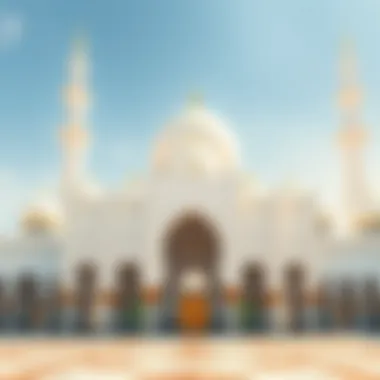
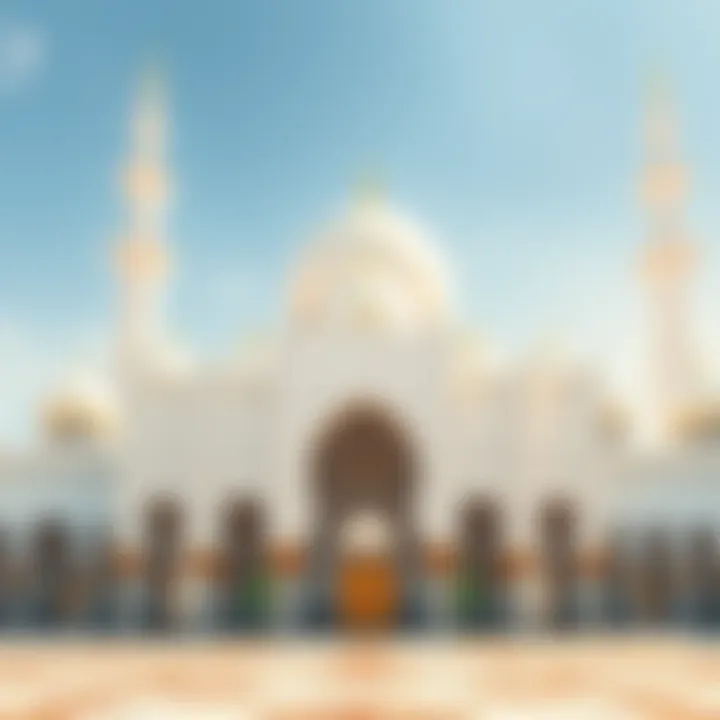
Intro
The Sheikh Zayed Grand Mosque, standing proud in Abu Dhabi, is a remarkable architectural feat that marries modern technique with traditional artistry. This mosque is not just a place of worship; it represents a profound cultural landmark, attracting thousands of visitors from around the world. From its striking white marble domes to its intricate mosaic floors, the mosque unfolds as a testament to the rich heritage of the United Arab Emirates.
As one steps into the mosque's serene ambiance, it becomes evident that this space is designed with intention. Every architectural element and design feature reflects a deep understanding of Islamic art and culture, ensuring that the mosque serves both its spiritual purpose and its role as a beacon of inclusivity and hospitality.
This article aims to explore the mosque's architectural brilliance, cultural impact, and the experiences it offers to all who visit. The mosque’s design draws heavily from various influences, incorporating elements from Moorish, Mughal, and Persian styles, which not only showcase the UAE's openness to cultural diversity but also highlight its commitment to preserving traditions.
In what follows, we will delve into the specific aspects of the mosque that contribute to its grandeur, including its historical context, design elements, and the role it plays within the community. This exploration extends to how the mosque shapes the UAE’s modern identity while being a critical part of its cultural heritage.
Prolusion to the Mosque
The mosque stands as a towering symbol of peace and coexistence in a region that is often characterized by its vast deserts and rich traditions. Located in the heart of Abu Dhabi, this architectural marvel is not just a place of worship; it embodies the spirit and aspirations of the United Arab Emirates as a whole. Understanding the importance of this mosque highlights the remarkable blend of modernity and tradition that defines the UAE’s cultural identity.
Significance in the UAE
In a country noted for its rapid development and cosmopolitan lifestyle, the mosque holds a place of revered significance. It serves not just as a religious site but as a cultural hub for residents and tourists alike. The mosque is a reminder of the UAE's commitment to tolerance and inclusivity. This is particularly significant in a region where different cultures and religions converge, offering a glimpse into the harmonious coexistence of diverse communities.
The mosque is often regarded as a beacon of knowledge and spirituality. It encourages dialogue among various faiths and acts as a bridge for many people seeking to understand Islamic beliefs and practices. Beyond spirituality, it contributes to the cultural landscape of the UAE, attracting visitors from all corners of the globe.
Overview of Key Features
The design and structure of the mosque are truly exceptional, distinguished by several key features that reflect both traditional Islamic architectural elements and contemporary innovations.
- Scale and Size: The mosque is one of the largest in the world. Its sheer scale is awe-inspiring, with capacity to accommodate thousands of worshippers inside its vast prayer hall.
- Materials Used: The construction incorporates high-quality materials such as white marble and intricate mosaics. These materials not only enhance its beauty but also withstand the harsh climate of the region.
- Architectural Style: A blend of various architectural styles—from Ottoman to Moorish influences—creates a unique aesthetic that resonates with many visitors.
- Crescent Finial: Topping the mosque’s dome is a stunning gold-plated crescent finial, a symbol commonly associated with Islam, making it a notable point of landmark in the cityscape.
- Reflection Pools: Surrounding the mosque are intricately designed reflection pools. These not only add to the visual appeal but also represent the concept of tranquility and introspection.
Visitors to the mosque experience a unique atmosphere that harmonizes visual grandeur with spiritual serenity. It's a space where artistry meets devotion, setting it apart as a true reflection of the UAE's identity meeting the modern world's demands.
"The mosque is a testament to our cultural heritage, showcasing not only our Islamic faith but also an inviting spirit toward all cultures and traditions."
Through its architectural beauty and cultural significance, this mosque transcends being just a religious institution; it has become a living entity that tells the rich story of the UAE. The following sections will delve deeper into its historical background, architectural design, and the many roles it plays in community and tourism.
Historical Background
Understanding the historical background of the UAE's largest mosque sets the stage for appreciating its grandeur and significance. This section delves into the origins and foundational moments that shaped the structure and its role in contemporary society. Recognizing the intertwined relationship between history and architecture gives context to the mosque’s importance as both a religious and cultural landmark.
Founding and Construction
The mosque’s construction began in 1996 and culminated in 2007. The vision behind the mosque emerged from the desire to reflect the cultural identity of the UAE.
- Sheikh Zayed bin Sultan Al Nahyan, the founding father of the UAE, commissioned this grand project. He aimed to create a space that would foster enlightenment, bridging the past with the present.
- The groundbreaking ceremony was a moment of unity. It gathered various leaders and citizens, reinforcing a collective sense of pride and purpose. This site wasn’t merely a construction project; it was a symbol of hope and resilience.
The architectural design was entrusted to the Yas Island-based firm, leading to an impressive collaboration of global talents. Over 3,000 artisans and craftsmen worked tirelessly, utilizing materials sourced from around the world, including Italy, India, and Iran.
This effort resulted in a majestic structure capable of accommodating 40,000 worshippers. The scale of the mosque is impressive, but the details are what enthrall visitors. Intricate tile work, exquisite stone, and shimmering chandeliers create an environment that feels both sacred and welcoming.
One cannot speak of this mosque without mentioning its impressive central dome, which is one of the largest in the world. Its height, paired with the surrounding minarets, creates a silhouette that commands attention, reflecting both a commitment to spiritual reflection and architectural brilliance.
Cultural Influences
The cultural influences intermingled with the mosque’s design are as rich as its construction history. Drawing on various styles, it encapsulates a blend of Moorish, Mamluk, and Ottoman designs. Each influence infuses the structure with layers of meaning, reflecting the Islamic heritage.
- Materials used in construction have a story to tell – marble from Greece, mosaics from Turkey, and carpets from Iran highlight the UAE's openness to artistic collaboration.
- Many artists visited to contribute their skills, weaving a diverse tapestry of art that transcends borders. This creation process itself is a testament to the UAE’s commitment to cultural exchange and Islamic values.

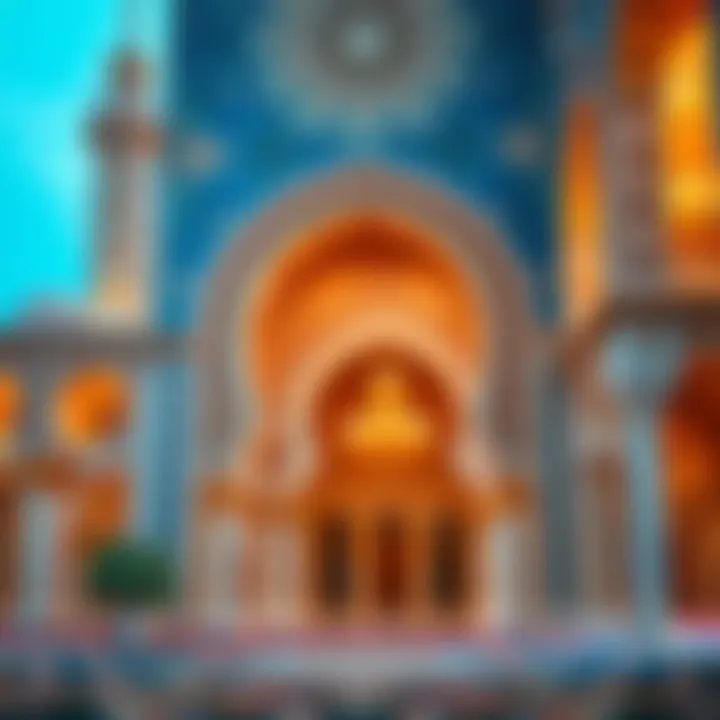
The mosque serves as a meeting ground for various cultures, echoing the UAE's position as a global hub. Its doors are open to anyone seeking knowledge or spiritual solace, regardless of background. Thus, the mosque stands not just as a place of worship but as a cultural sanctuary, inviting reflection and connection among diverse peoples.
"This mosque does not merely stand on the land; it acts as a bridge connecting the tradition of the past with the modernity of the future."
In summary, the historical background of the mosque reveals how foundational decisions and cultural dialogues have shaped it into what it is today. As visitors walk through its corridors, they can feel the echoes of its creators' intent, the souls that laid bricks and the hopes that rise in the domes above.
Architectural Design
The architectural design of the UAE's largest mosque serves as more than just a visual spectacle; it embodies the spirit, culture, and aspirations of the nation. This topic is significant as it sheds light on how architecture can encapsulate a community’s values, reflect its history, and inspire future generations. In a world where buildings are often mere constructions, this mosque stands apart, woven into the fabric of the UAE’s identity.
Design Philosophy
The design philosophy behind this remarkable structure is one of harmony and unity. The mosque is not only a place of worship but a focal point for cultural exchange and community gathering. The architects drew inspiration from traditional Islamic architecture, blending it seamlessly with modern design principles.
The use of symmetry is paramount in its design, symbolizing balance in life and faith. The mosque's main dome towers prominently, representing a connection between the earthly and the divine. Furthermore, the incorporation of intricate geometric patterns speaks to the deep-rooted heritage of Islamic art, lending both esthetic value and a sense of tranquility.
Materials and Craftsmanship
The materials chosen for the construction reflect a commitment to quality and authenticity. Local artisans used a variety of materials including white marble from Macedonia, which not only gives the mosque a resplendent glow but also signifies purity. Additionally, artisans worked meticulously to create elaborate mosaics and calligraphy that adorn the walls, showcasing not only their skill but also the cultural narrative of the UAE.
"The craftsmanship involved in the mosque’s construction is a testament to the talent of the region's artisans, showcasing traditional skills in a contemporary context."
The attention to detail in every corner—from the beautifully carved wooden doors to the exquisite chandeliers—is indicative of a labor of love that transcends mere construction. Each element has been thoughtfully considered, aiming to create an atmosphere of reverence and peace.
Size and Capacity
Size has its own kind of significance within the context of this mosque. Covering an area of more than 22,400 square meters, it stands as a symbol of openness and inclusiveness. The mosque can accommodate over 40,000 worshippers, reflecting a commitment to community and spiritual gathering.
The sheer magnitude of the mosque is not only an architectural feat but also serves a practical purpose. It provides a vital space for worship, education, and community events, reinforcing the mosque's role as a hub of cultural activity. From large-scale gatherings during Ramadan to quiet individual reflection, the mosque is adaptable to many spiritual needs.
The space, with its vast courtyards and prayer halls, is designed to allow for a natural flow of people, which enhances the experience of visitors and worshippers alike. This architectural savvy ensures that it is accessible while maintaining a sense of grandiosity that is fitting for its status as a national landmark.
Cultural and Spiritual Role
The cultural and spiritual role of the UAE's largest mosque extends beyond its impressive architecture and serene beauty. This significant edifice serves not only as a place of worship for Muslims but also as a central hub for cultural exchange and community engagement. In a rapidly evolving society like the UAE, marked by a myriad of cultural influences, the mosque stands as a beacon that shines light on the essence of spiritual connectivity and cultural heritage.
Community Services
One of the most distinctive features of this mosque is the array of community services it offers. These services are aimed at nurturing the local population and creating a sense of unity among residents. For instance, the mosque frequently organizes community gatherings, interfaith dialogues, and cultural festivals—events that bring people from diverse backgrounds together in harmony.
Additionally, the mosque provides essential assistance to those in need through various outreach programs. Food drives during Ramadan, for example, underscore the mosque’s commitment to social welfare. These initiatives are a testament to how the mosque embodies the Islamic principle of charity, fostering a spirit of generosity and communal responsibility.
- Weekly charity meals help feed low-income families.
- Educational workshops on Islamic teachings serve to enlighten both Muslims and non-Muslims.
- Support for new residents in navigating their lives in the UAE enhances community cohesion.
"In a world full of change, the mosque embodies a constant source of support and strength for its community."
Moreover, these services play a pivotal role in alleviating social tensions, as they encourage interactions among residents that promote understanding and acceptance. The mosque is not merely a sacred space; it's the heartbeat of the community, fostering bonds that transcend cultural barriers.
Educational Programs
Educational programs held at the mosque provide a bridge to knowledge for people of all ages. These programs cater to a broad audience, reflecting the mosque’s commitment to being a center for learning and spiritual growth. Regular classes on Quranic studies, Arabic language courses, and programs geared toward understanding Islamic history help enrich the minds of many.
In particular, special sessions designed for children focus on nurturing core values such as respect, patience, and knowledge. In a lively atmosphere where they can freely ask questions, youngsters learn about their faith while developing a strong sense of identity.


- Weekly Quranic recitation classes promote appreciation for the holy text.
- Workshops on Islamic art and calligraphy engage artists and hobbyists alike.
- Family counseling sessions provide guidance to families, fostering healthier relationships.
The role of education at the mosque is not just limited to Islamic teachings. Programs also address contemporary issues, equipping attendees with critical thinking skills necessary for navigating the complexities of modern life. This dual focus on both spiritual and worldly matters ensures that the mosque remains relevant and serves the community effectively.
In essence, the cultural and spiritual role of the UAE's largest mosque cannot be overstated. It offers a multi-faceted approach to community cohesion through services and education, fostering an inclusive environment where everyone is welcome. As the congregation grows, so does the mosque’s mission to educate, uplift, and inspire those it serves.
Visitor Experience
The experience of visiting the UAE's largest mosque is not merely about marveling at its grandeur; it encompasses a multi-faceted journey that intertwines spirituality, culture, and architecture. Visitors can expect an enriching glimpse into the UAE's identity and its embrace of both tradition and modernity. From the moment one steps through the grand entrance, the mosque offers a serene atmosphere that invites reflection and admiration.
Public Access and Guidelines
Access to the mosque is designed to be inclusive, welcoming people from all walks of life. However, to maintain the sanctity of the space, there are certain guidelines to follow. Visitors are encouraged to dress modestly, which includes wearing clothes that cover the arms and legs. Women are required to wear a headscarf, a specific measure to show respect for the religious and cultural values the mosque embodies.
Arriving early is advisable, as peak visiting times can create long queues. The mosque opens its doors to the public most days, but hours may vary during the holy month of Ramadan.
Many essential visitors’ tips include:
- Plan your visit during off-peak hours for a more personal experience.
- Respect the sacred surroundings; silence is appreciated as worshippers may be in prayer.
- Photography is permitted in most areas, but always check for signs indicating restricted zones.
Exploring this magnificent mosque provides insights that go beyond its physical beauty, delving into the cultural heart of the nation.
Guided Tours
For those wishing to gain a deeper understanding of the mosque’s history and significance, guided tours are an excellent option. These tours are often led by knowledgeable guides who share engaging narratives about the mosque’s design, its cultural impact, and its role in the community. They might highlight fascinating aspects like the intricate details of its 82 domes or the stunning Persian carpets that decorate the prayer hall.
Guided tours typically cover a variety of key elements:
- Historical context about the mosque's foundation and the people behind its creation.
- Architectural nuances that showcase the blend of Islamic art and modern techniques.
- Q&A sessions, allowing visitors to inquire about any aspect they find intriguing.
Most tours are available in multiple languages, further broadening accessibility for international tourists. Participants often leave with a sense of connection, not only to the mosque but to the rich tapestry of cultural narratives that the UAE represents.
The experience culminates not just in a visit but in an opportunity to cultivate an appreciation for a national treasure, which stands as a symbol of peace and community while inviting global dialogues on tradition and modernity.
Role in Tourism
The role of the UAE's largest mosque in the tourism sector cannot be understated. This grand establishment has become synonymous with the cultural fabric of Abu Dhabi, akin to a shining beacon drawing global travelers. Its physical presence not only enriches the cityscapes but also offers insights into the rich Islamic heritage of the region. Travelers from all corners of the globe flock to witness the fusion of traditional art and modern architecture, making it a veritable landmark of interest.
Attracting Global Visitors
When discussing the mosque's capacity to attract visitors, one must consider several compelling factors. First and foremost, its architectural splendor is a prime draw. Spanning a staggering area, the mosque's vastness offers an immersive experience for first-time visitors. Tourists often remark on the calm and serene atmosphere, which stands in sharp contrast to the bustling life outside. This tranquility compels many to linger longer than expected, allowing them to soak in the precision of the craftsmanship.
Moreover, cultural tours enhance the visitor experience. Guided tours are available, providing insights into Islamic traditions and the mosque's significance. Such tours cater to a variety of interests, from general tourism to specific educational needs, addressing the curiosity of both secular and religious visitors. Each step of the journey reveals stories woven into the very brick and mortar of this majestic structure.
Impact on Local Economy
The mosque’s role extends beyond just tourism; it significantly contributes to the local economy as well. With millions of visitors annually, the demand for services surrounding the mosque surges, from hospitality to transport. Local businesses, including hotels, restaurants, and shops, see an uptick in their revenue streams as tourists seek accommodation, dining, and souvenirs.
This influx of tourists creates jobs, not just within the tourism industry but also in sectors like retail and public services. The economic ripples reach further, impacting areas like construction, as the need for infrastructure to support the growing number of visitors becomes critical. This serves to forge a connection between cultural tourism and economic growth that benefits the wider community.
"Cultural tourism creates a synergy that fosters economic resilience while ensuring that the essence of heritage is preserved for future generations."
In essence, the mosque is not merely a place of worship. It is an intersection where spirituality meets commerce, offering insights about Emirates' identity while fueling growth in various sectors. The blend of spiritual significance and economic vitality makes the mosque a key player in the tourism landscape of the UAE.
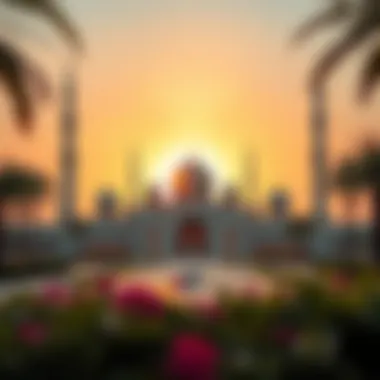
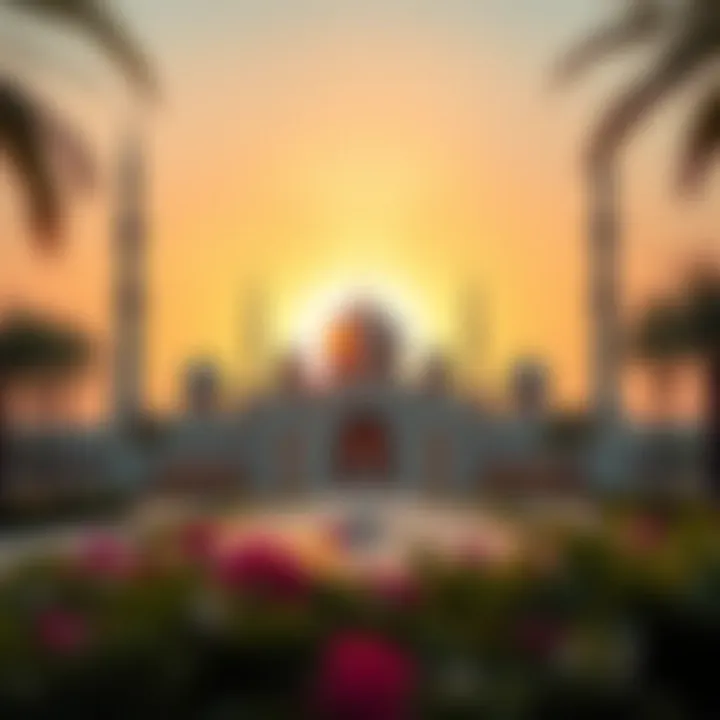
Comparative Analysis
Comparison with Other Mosques
When placed alongside other famous mosques like the Sheikh Zayed Grand Mosque in Abu Dhabi, the Great Mosque of Samarra in Iraq, or the Al Haram Mosque in Mecca, certain distinguishing traits emerge that set the UAE mosque apart.
- Architectural Diversity: The UAE mosque incorporates various architectural styles, reflecting both local traditions and global influences. Its grand domes and detailed mosaics evoke the opulence found in Ottoman mosques, while certain elements might remind one of Persian artistry.
- Size and Scale: Compared to the Great Mosque of Mecca, which is the largest in the world, the UAE mosque is not as vast, but its intricate details and spacious courtyard offer a different kind of experience that is more intimate.
- Community Integration: While many mosques serve primarily as places of worship, the UAE mosque also acts as a cultural hub, frequently hosting art exhibitions, interfaith dialogue, and educational programs. This role is particularly pronounced when contrasted with more traditional mosques that primarily focus on religious functions.
In this way, comparing the UAE mosque with its global counterparts reveals how it stands as a beacon of modern Islamic architecture, bridging historical styles while enhancing its community role.
Unique Attributes
Every renowned structure typically possesses a set of unique features that differentiate it from its peers, and the UAE's largest mosque is no exception. Some noteworthy attributes include:
- Innovative Lighting Design: The mosque is famous for its stunning light displays, which change with the time of day and season, creating a dynamic interaction between the building and its environment. This is not just an aesthetic choice; it reflects the Islamic concept of bringing light into places of worship.
- Cultural Symbolism: The mosque is not just an architectural piece but a symbol of the UAE’s cultural identity, showcasing the blending of tradition and contemporary values. The design elements often incorporate local flora and fauna, representing the natural beauty of the desert landscape.
- Reflections of Unity: The park that surrounds the mosque provides communal space, encouraging gatherings and understanding among diverse cultures. This accessibility sets it apart from many mosques, where often the physical space can be less inviting.
"The incorporation of local elements in the mosque’s design speaks to a broader narrative about how the UAE sees itself — a bridge between ancient traditions and modern aspirations."
Future Developments
The topic of future developments regarding the UAE's largest mosque is paramount, especially considering its growing significance in the ever-evolving societal landscape of Abu Dhabi. This section aims to shed light on the continuing initiatives focusing on preservation and community engagement, which are vital for maintaining its cultural relevance and architectural integrity.
Preservation Efforts
When it comes to preserving such a monumental structure, the importance cannot be overstated. Preservation efforts ensconce not only the physical aspects of the mosque but also encapsulate its historical narratives. The fabric of the mosque reflects both the architectural advancements and the craftsmanship of the region, making its preservation a priority on multiple fronts.
Key components that serve to bolster preservation include:
- Regular maintenance protocols, ensuring that the infrastructure remains intact and resilient against climate impacts.
- Documenting restoration processes through detailed reports, while harnessing modern technology such as 3D modeling to assess structural integrity.
- Incorporating sustainable practices into maintenance, which may involve using eco-friendly materials or minimizing energy consumption with advanced lighting systems.
Such meticulous attention to preservation not only safeguards the tangible structure but also enhances the community's connection with their heritage. Visitors will continue to appreciate the exemplification of artistic prowess paired with cultural stories, thanks to these efforts. Moreover, the mosque sets a precedent for future architectural endeavors within the UAE, illustrating a commitment to heritage being modernized rather than erased.
Evolving Community Engagement
In parallel to preservation initiatives, evolving community engagement strategies are becoming increasingly significant. The mosque's role transcends mere spiritual sanctuary; it serves as a nexus for cultural exchange and community gatherings.
Strategies to enhance community engagement include:
- Cultural Programs: Regular workshops and events that highlight local arts, crafts, and traditions, inviting the community to actively participate, thus creating a vibrant cultural dialogue.
- Educational Initiatives: Collaborating with schools and universities offering educational tours that introduce students to Islamic culture, principles, and the architectural majesty of the mosque, ensuring younger generations appreciate and understand their cultural heritage.
- Volunteer Opportunities: Creating various platforms where community members can volunteer for upkeep or educational programs fostering a sense of ownership and pride.
Engagement with diverse community groups is essential for the mosque's future relevancy. By opening its doors to various cultural dialogues, it allows for a more inclusive atmosphere, stimulating discussions that can lead to broader understanding among citizens and expatriates alike. Ultimately, these engagement initiatives are focused on fostering a collective identity, ensuring that the mosque is not just a historical site but an active contributor to the local cultural fabric.
"Preservation and community engagement are two sides of the same coin, both pivotal for nurturing the legacy of a landmark that stands as a symbol of cultural unity."
By understanding and investing in future developments, not just in renovation but also in engagement methods, stakeholders can significantly influence how the mosque will continue to inspire both the present and future generations.
Closure
In wrapping up our exploration of the UAE's largest mosque, it becomes clear that this remarkable institution is more than just an architectural masterpiece. It serves as a beacon of cultural identity for the nation. One cannot overstate the significance it holds for the local community and visitors alike.
Reflections on the Mosque's Impact
The mosque transcends its physical presence. It stands as a tribute to the Emirati spirit, uniting people from all walks of life within its grand halls. The impact of the mosque is palpable, reaching beyond mere aesthetics. It encourages dialogue and understanding among diverse cultures. People often find themselves reflecting on their own beliefs and values within its walls. The spiritual environment fosters a sense of peace that resonates deeply with everyone who visits. Moreover, the mosque amplifies tourism in Abu Dhabi, drawing in visitors eager to experience its grandeur firsthand. Its role in preserving and promoting Islamic values enhances the cultural fabric of the entire region.
Final Thoughts on Cultural Identity
As we take a step back and consider the broader implications, the mosque emerges as a crucial player in shaping the United Arab Emirates' cultural identity. It opens doors, not just to its lavish designs but also to a rich tapestry of history and heritage. In a world often steeped in division, this architectural wonder signifies unity and mutual respect. As expatriates, investors, and homebuyers navigate this unique landscape, recognizing the mosque's role can provide valuable insights into the essence of Emirati life.
The UAE's largest mosque stands as a testament to the ideals of tolerance and coexistence. Through its continuous engagement with local and global communities, it cultivates a sense of belonging and pride. In understanding its importance, we not only appreciate its aesthetic value but also acknowledge how it contributes to the evolving narrative of cultural identity, both within the UAE and beyond.
"The mosque is not merely a place of worship; it is a gateway to understanding and appreciating a culture that beckons to be explored."



